Yacht Devices J1708 Engine Gateway brings data from older engines to NMEA 2000
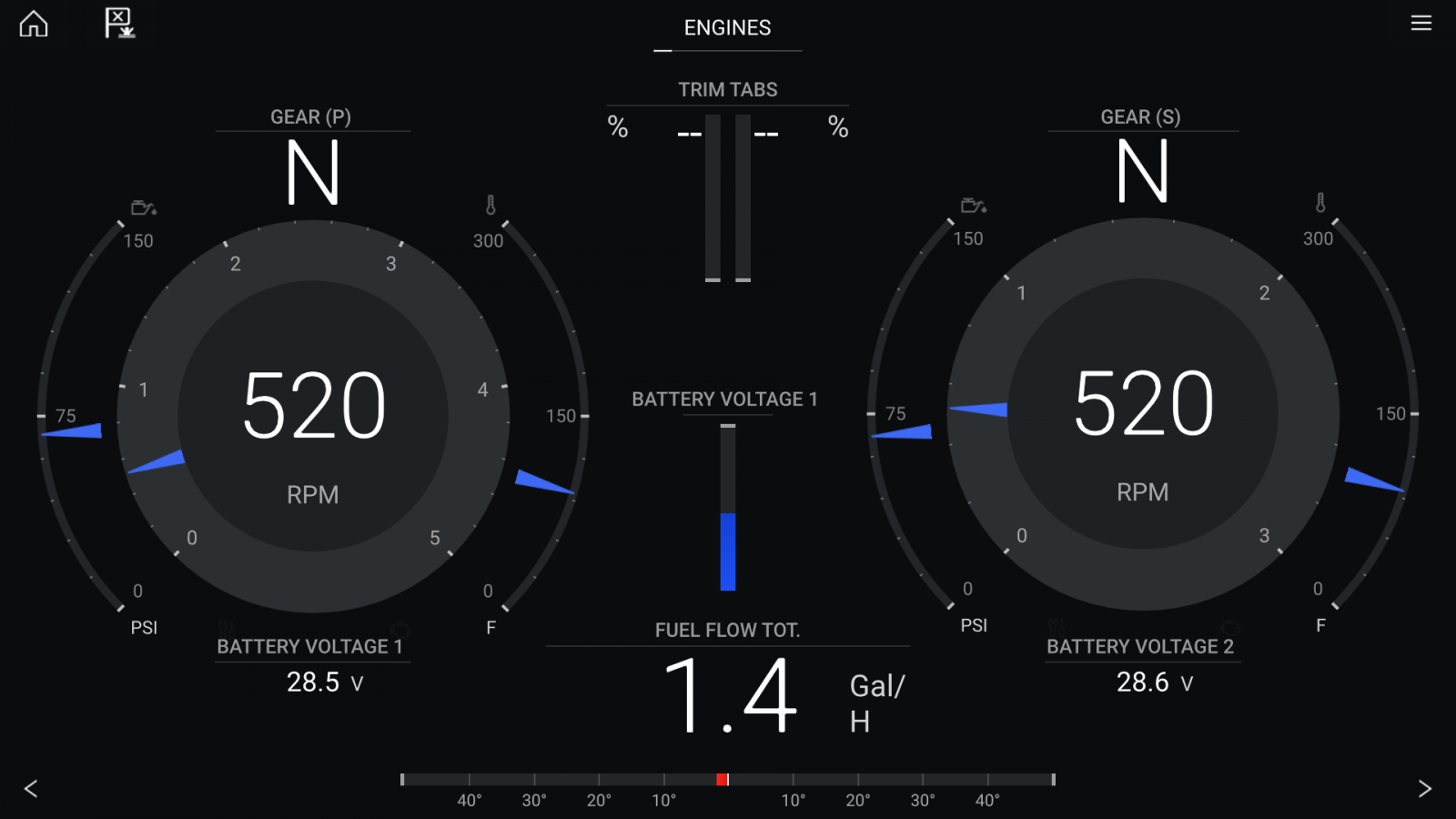
When I bought Have Another Day I really wanted the data from my early electronically controlled diesel engines available on my MFDs. I’ve had access to this data previously and knew the value of the data for fuel management and engine monitoring. My path to getting that data wasn’t easy but I think I helped blaze a trail to easy engine data on your NMEA 2000 network.
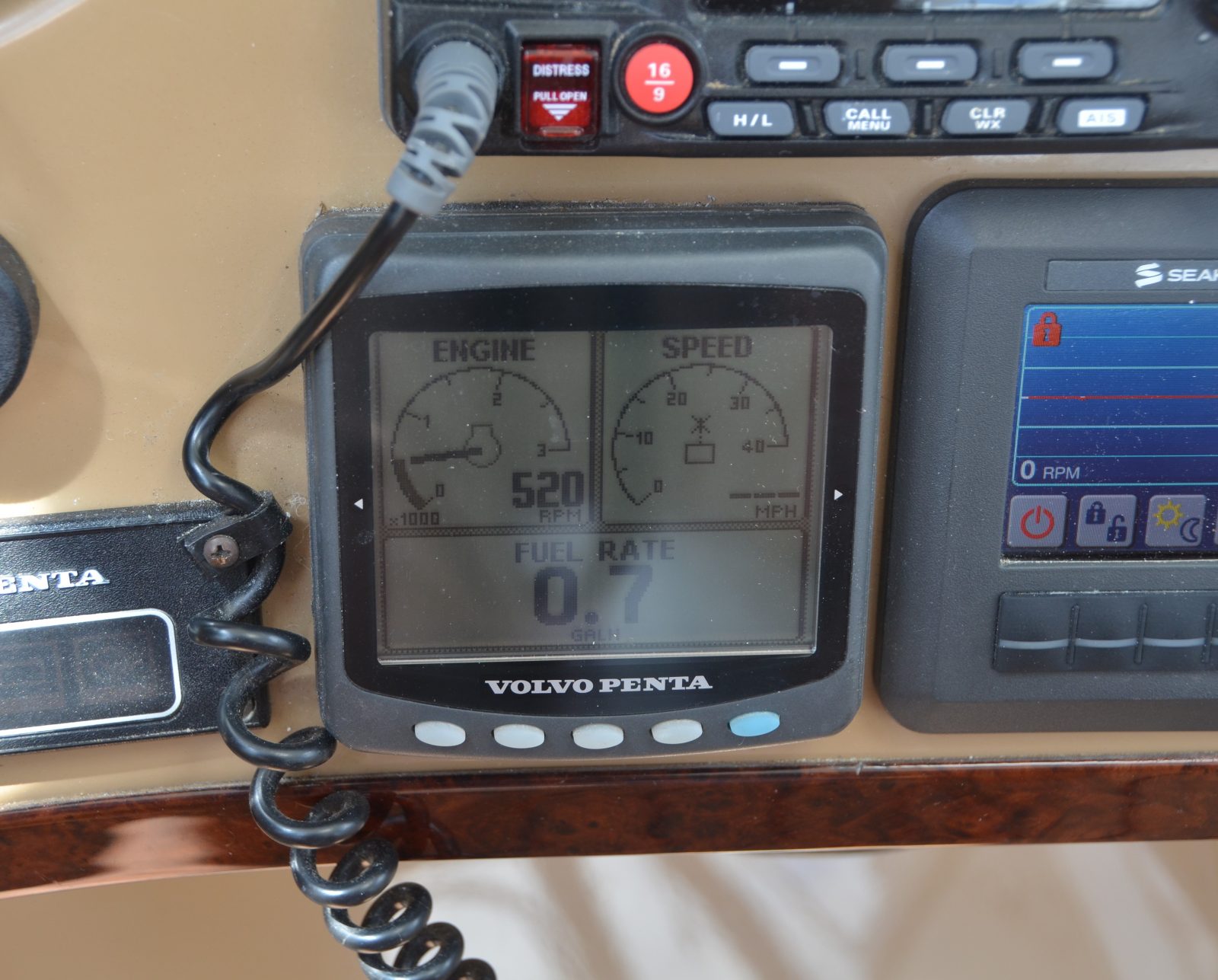
The monochrome 4″ electronic engine displays that came on board Have Another Day only display a few pieces of data at a time and don’t age well. As they get older the displays tend to become heat sensitive — turning off in direct sunlight isn’t an attractive habit for engine displays — and the displays develop dark spots making them very hard to read. My displays exhibited both problems and after spending several boat units repairing them I decided to redouble my efforts to find a workable NMEA 2000 option.
Failed attempts
When I bought Have Another Day one of my first projects was to connect her 2002 era Volvo-Penta D12 EDC engines to a NMEA 2000 network. Research at that time suggested the engines likely communicated using J1939. My first try was a Maretron J2K100, an excellent J1939 converter, but I couldn’t get any data out of it. Eventually I ordered a Yacht Devices YDEG-04 (also a J1939 to NMEA 2000 converter) because I read of success with older Volvo-Penta engines. Lots of back and forth with Yacht Devices resulted in finding an RPM only J1939 stream used for RPM sync. Unfortunately, that turned out to be the only usable data on that stream.
A Solution
Over the course of several months I worked with Yacht Devices’ principal, Aleksandr Gorlach, and an oscilloscope to capture the data on the CAN bus network between the engines and the display. From these captures Aleksandr figured out the engines and displays were using J1708, an older serial protocol used by industrial engines. As a result, Yacht Devices developed the YDES J1708 to NMEA 2000 engine gateway.
The YDES-04 — available both with NMEA 2000 DeviceNet connectors and Raymarine SeatalkNG connectors — is capable of decoding J1708 (the physical protocol) carrying J1587 (the logical data protocol) and Volvo-Penta’s KAD protocol (used on KAD and TAMD series engines). The list of supported data varies by protocol with a fuller set of data supported via J1587.
The table above shows not only the data available via each protocol but also what data can be substituted into the data stream from another sensor. Substitute data can come from other Yacht Devices sensors to augment data the original engine control unit (ECU) didn’t provide. The KAD series engines didn’t run the oil pressure sensor into the ECU so the YDES doesn’t have access to that information. But, you can use a Yacht Devices tank adapter (which can convert any resistance type sender’s data to NMEA 2000) to read values from the pressure sensor and insert those readings into the engine data stream.
Installation
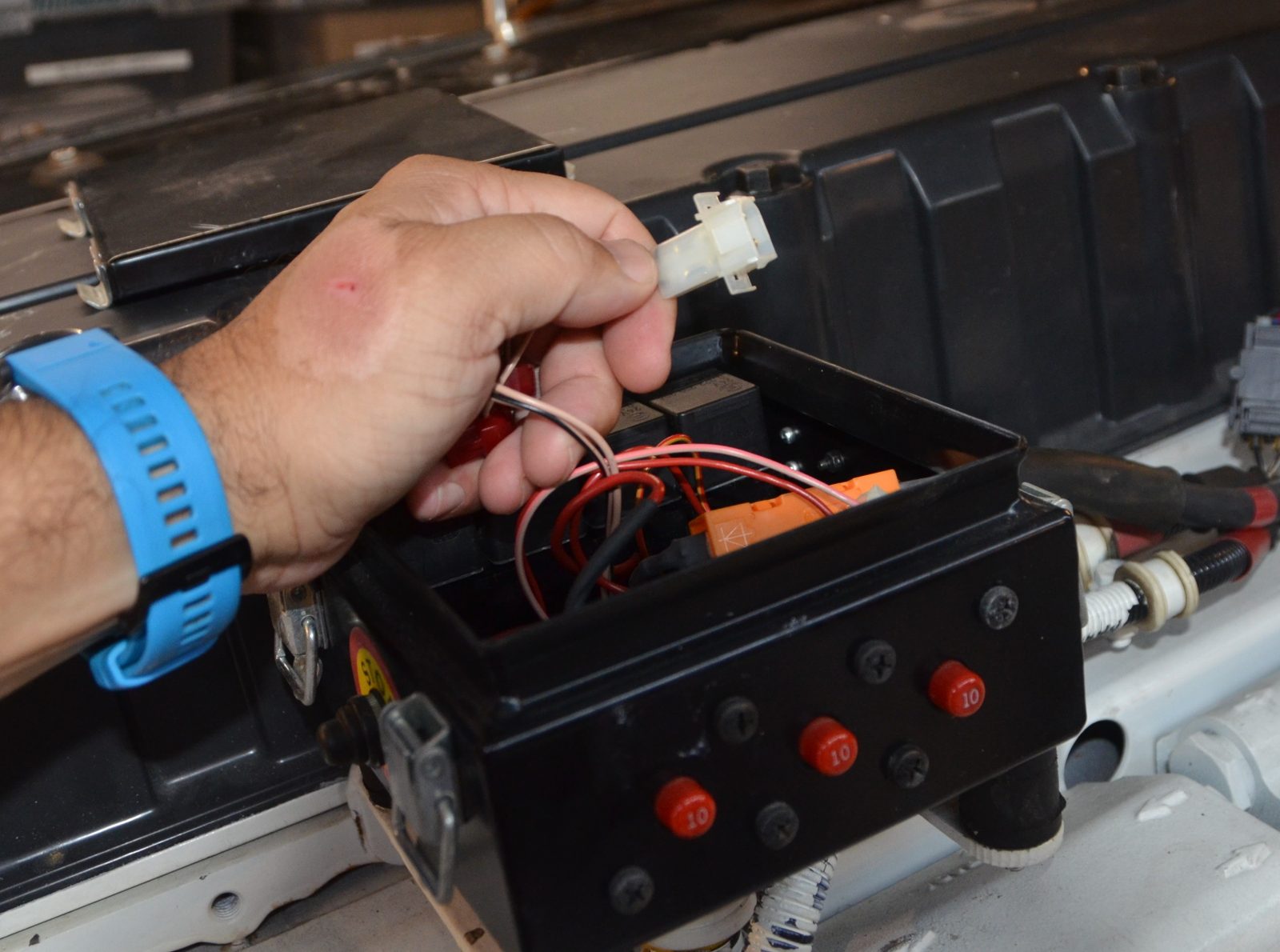
Installation varies from engine to engine. On most of the Volvo-Penta EDC I and II engines it’s quite simple. The white, nylon, two-pin connector that comes on the YDES is the mate to the diagnostic connector on the engine. In Volvo-Penta TAMD-73,74 and 75 engines as well as D12s that connector is located in a black metal box on top of the engine. Physical installation is as simple as connecting to the two-pin diagnostic connector in the box and connecting the other end of the YDES to your NMEA 2000 (or SeatalkNG) network.
Once the device is physically connected it may need some configuring. Like many of Yacht Devices’ products, configuration is performed with a text file copied onto a MicroSD card and then inserted into the card reader on the top of the device. The sample configuration above sets the engine ID to 1 (port is 0 and starboard is 1), tells the gateway to use the KAD protocol (if this is set to auto, the gateway will typically self discover between J1587 and KAD without trouble), sets an hours offset of 1250 (for cases where an ECU has been replaced), sets the fuel to diesel, tells the gateway to use the builtin requests for engine data (rather than user defined requests for unusual engine configurations), and finally tells the gateway to substitute oil pressure data from the sensor with an instance ID of 5. Once the configuration is read, it’s written to the device and the MicroSD card can be removed.
Using the data

Once engine data is on NMEA 2000 the data can be displayed on any NMEA 2000 compatible display. Above is a screenshot of the web gauges built into all of Yacht Devices WiFi gateways displaying data from my engines. These gauges and a cheap tablet can make an effective second set of gauges anywhere on the boat.

Engine data displayed on a Garmin 8612 
Engine data displayed on a Raymarine Axiom Pro 16 
Engine data displayed on a Simrad Evo3 NSS12
If you’re reconfiguring your helm, displaying engine data on an MFD or small gauge display can recover precious dash space from your analog gauges. A side note on that, if you’re going to remove analog gauges and have the opportunity I’m a big fan of keeping them mounted somewhere on the boat, perhaps in the engine room above the engines.
Other Engines
I’ve concentrated on Volvo-Penta engines with the YDES but it is also suitable for several other engine manufacturers who used J1708. Caterpillar and Cummins used J1708 for several years on a number of their engines.
But, starting in about 2004, J1939 replaced J1708 as the protocol of choice. There are now many engines including Caterpillar, Cummins, Volvo-Penta, Yanmar, gasoline engines with MEFI-4B (and later) ECUs, and many others that utilize J1939. Yacht Devices offers the YDEG-04 J1939 gateway, Maretron offers the J2K100 and now quite a few MFD manufacturers are beginning to build J1939 converters right into their high-end MFDs.
For owners of older engines without an ECU there are several options. Actisense offers the EMU-1 and Noland Engineering has the RS11. Both are analog to NMEA 2000 gateways. Ben Ellison has an EMU-1 running on Gizmo and has been quite pleased with the results. Both these options will require more installation, configuration and calibration work than the protocol converter gateways that are largely plug and play.
Lastly, for owners of gasoline boats with MEFI-1, 2, 3, or 4 ECUs, Fox Marine has a series of gateways for converting from these ECUs to NMEA 2000.
Regardless of which converter is employed, I believe the returns from engine data on NMEA 2000 are clear. Many early electronically controlled engines weren’t outfitted with electronic displays. Without these displays operators don’t have a way to monitor fuel flow — without use of separate flow meters. Access to fuel flow data can massively improve efficiency. I keep tabs on my fuel flow and speed when running. I frequently find that reducing my RPMs just a little bit may result in a drop of multiple gallons-per-hour of fuel consumption but only cost me one or two tenths of a knot.
I’ve helped lots of folks install engine gateways so if you have any questions, please fire away in the comments.
Note: This entry focuses on Yacht Devices‘ products. In addition to being the publisher of Panbo, I own the U.S. distributor of Yacht Devices. It was actually the process of getting my engines monitored that caused me to start working with Yacht Devices. We have high standards for impartiality at Panbo and I’ve taken great pains to ensure the editorial side of Panbo is always kept separate from advertising or any other businesses I’m involved in. Our about page describes our commitment to keeping the two separate and I welcome a conversation about any concerns or desire for clarification.


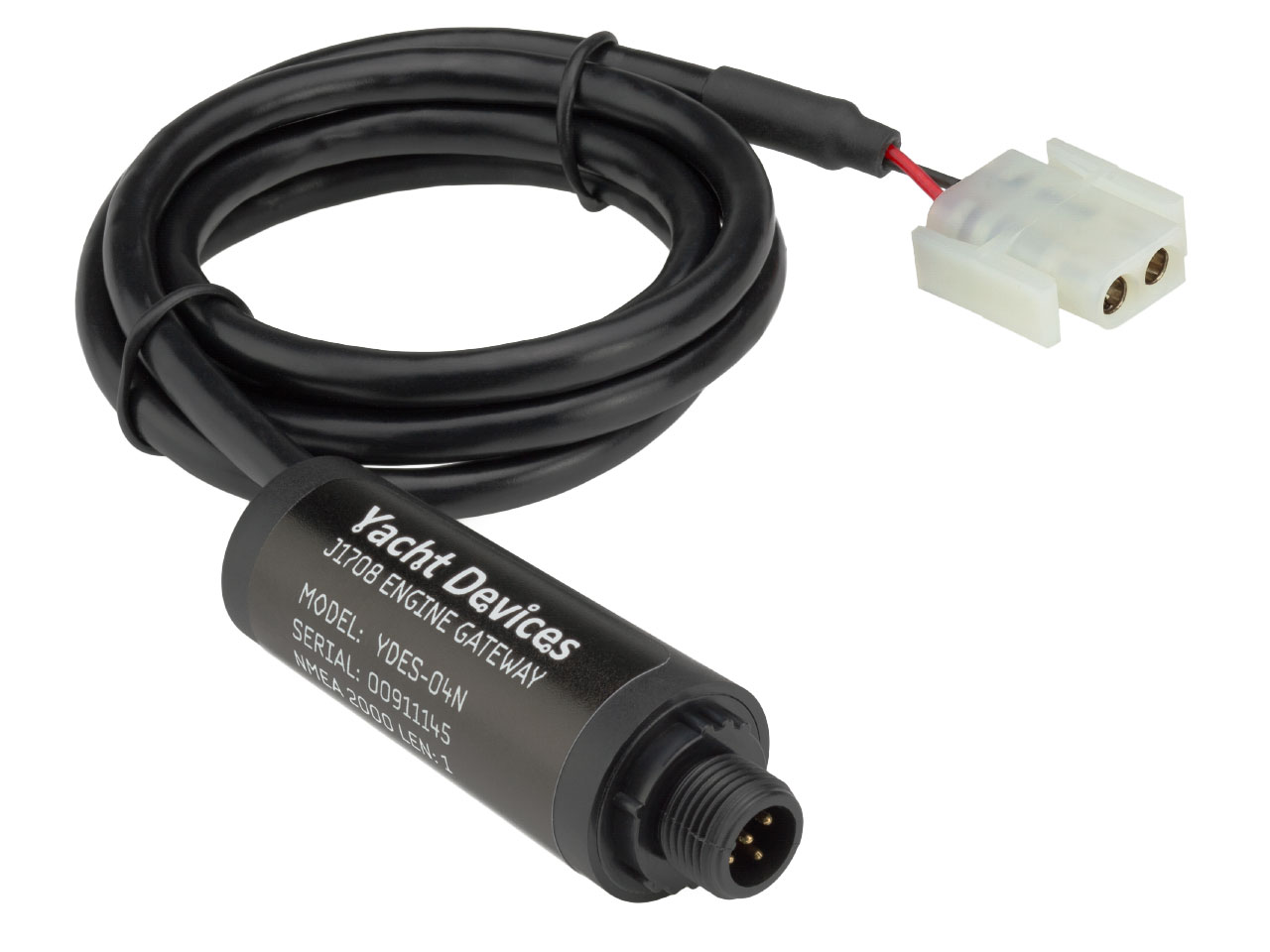
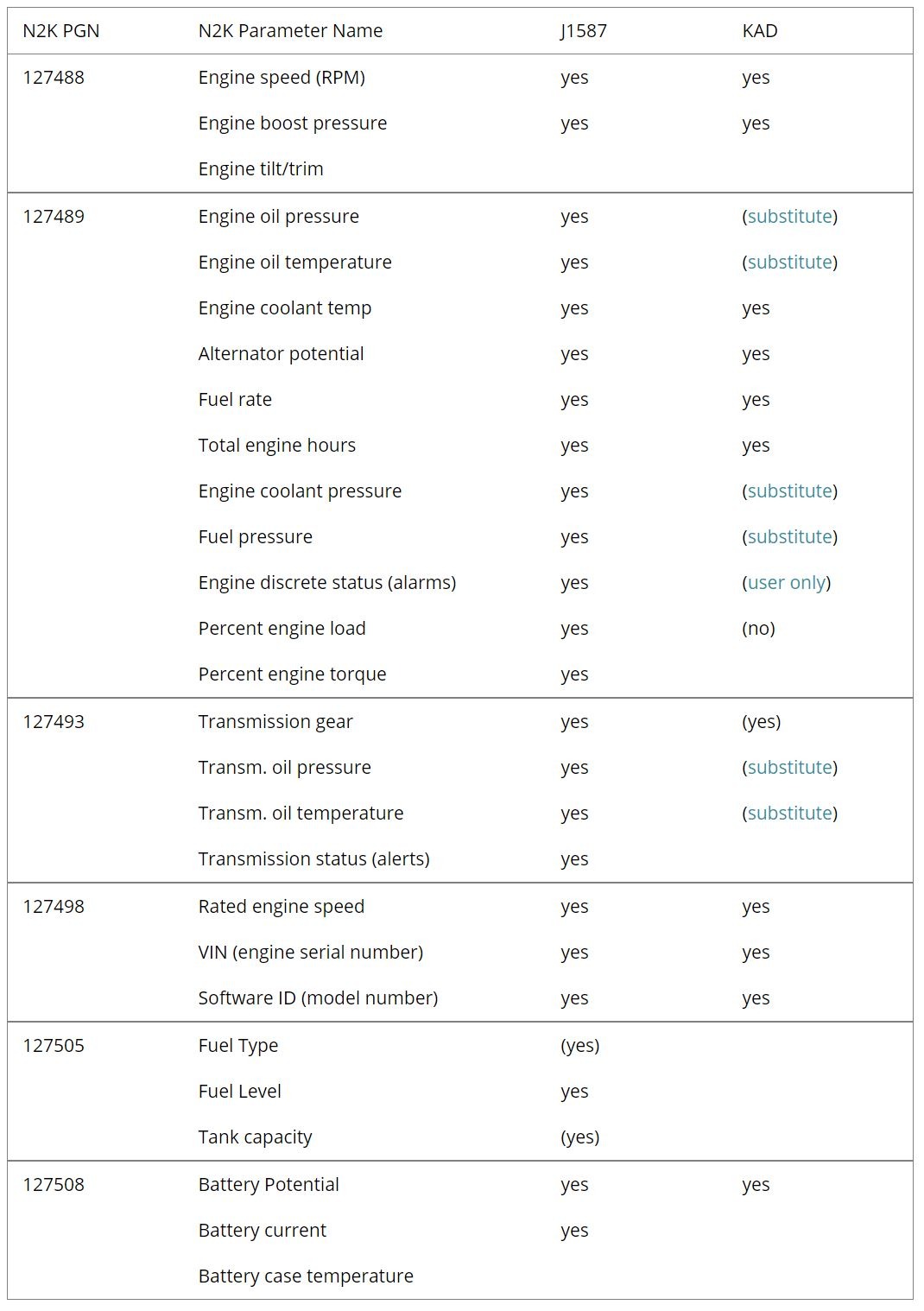

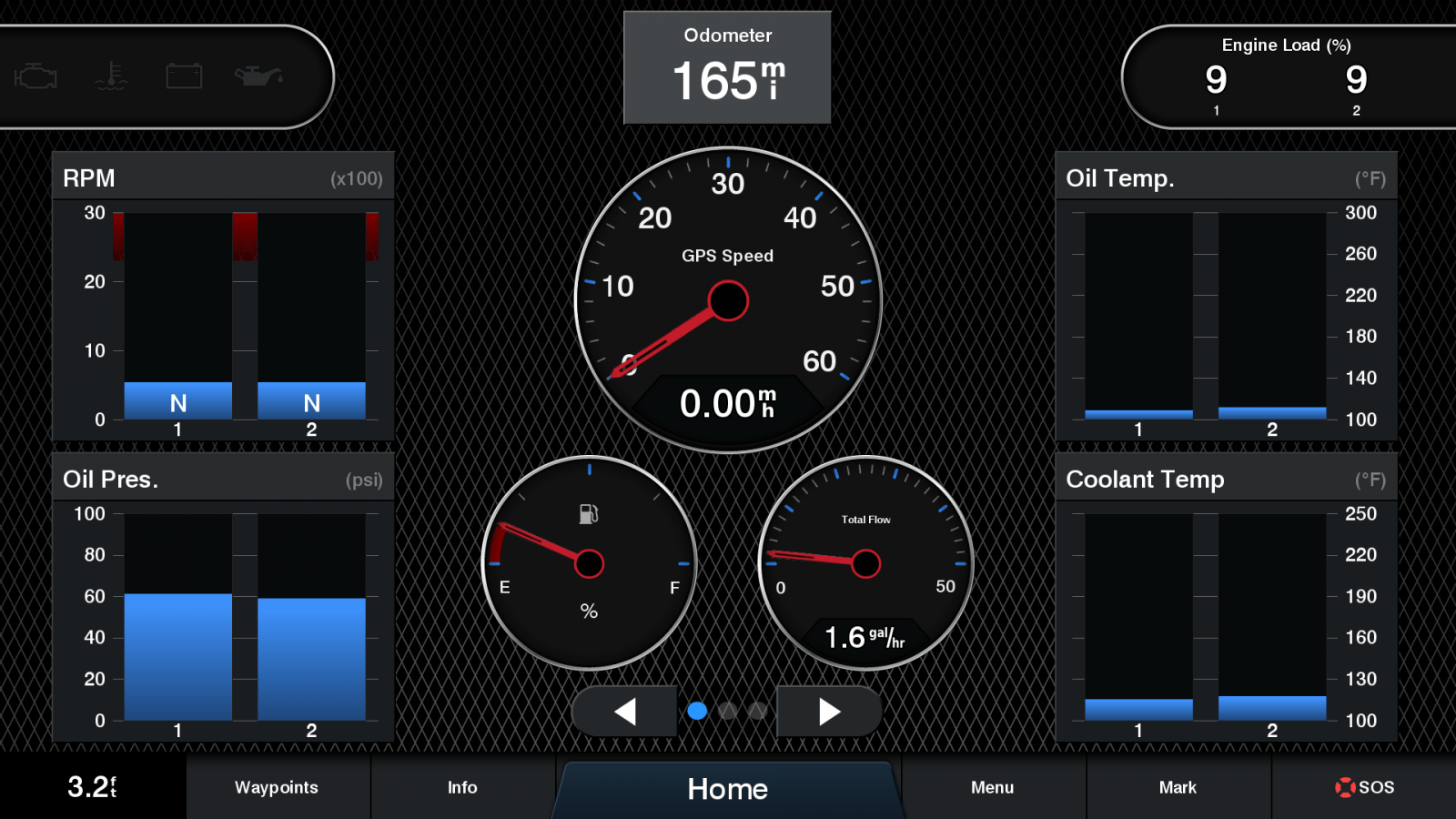







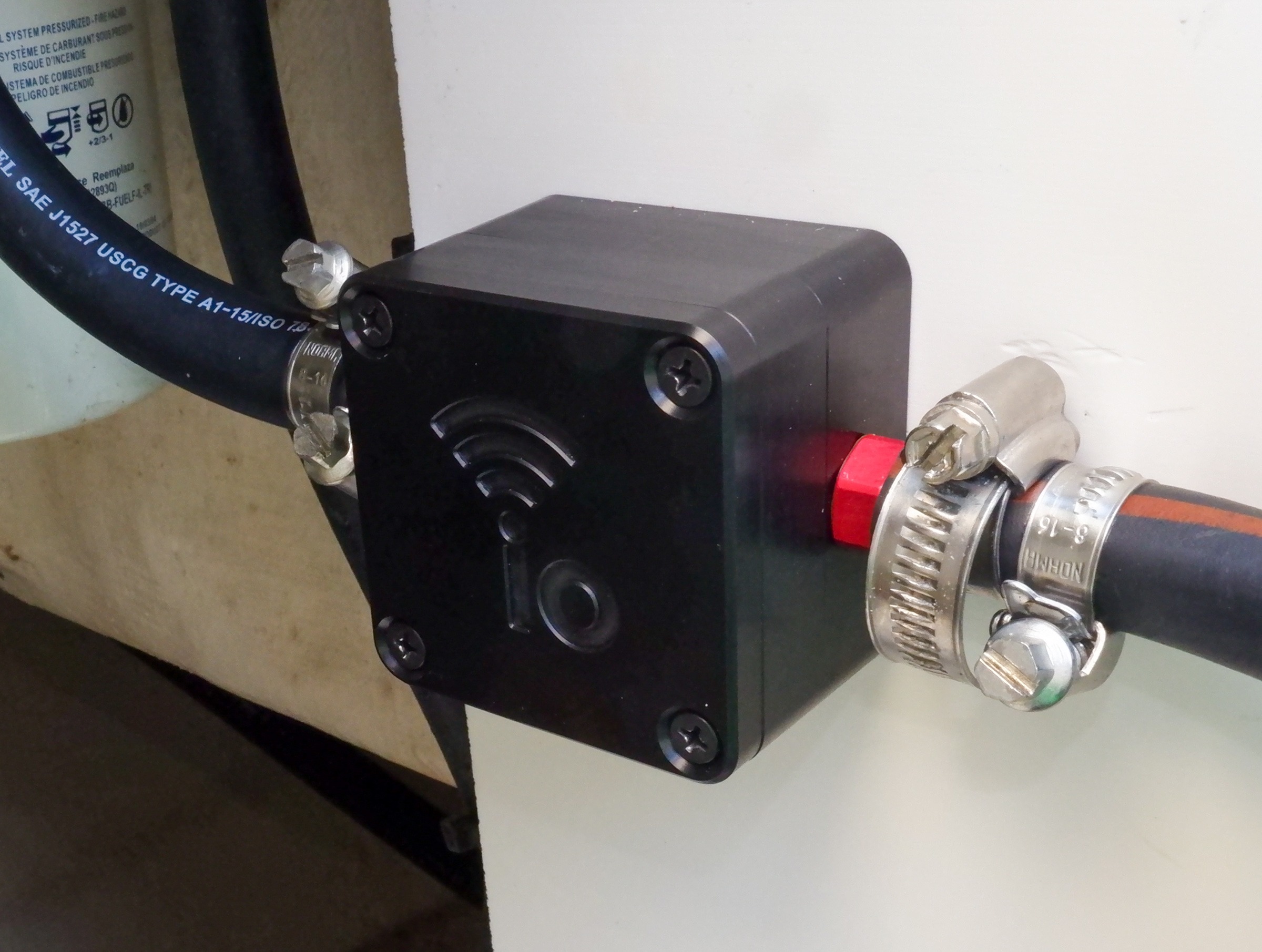
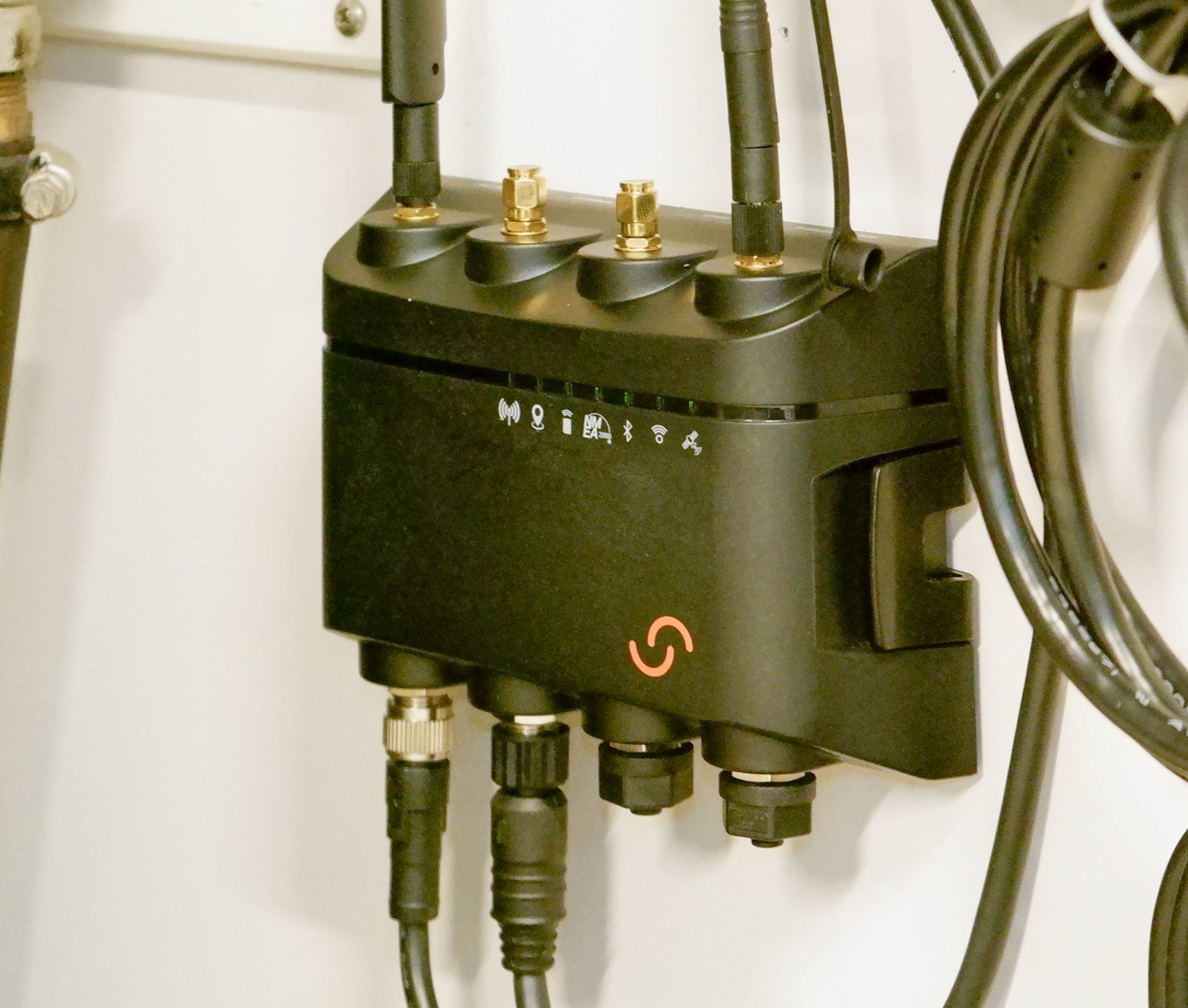







Good article. Also this product for Yanmar http://mbwtech.com/node/127. I’ve not used it yet but for this investigating it looks like a good plug and play solution.
Very interesting. Do you know if this device would work on a 2002 Luggar L6108A2?
Patrick,
I believe the L6108A2 is an entirely mechanical engine. The protocol converters (YDES, YDEG, J2K100, etc) are all designed to interface with an ECU which isn’t present on the L6108A2. So, I think your only option would be the EMU-1 or RS11.
Great and timely article. Maybe you can help me with my own setup. I a have a 2006 Volvo Penta D6-260I-B with a Volvo Penta NMEA 2000 Gateway No. 3840289, Serial No. 06260017 (original equipment with the boat) and a Garmin 5212 MFD. The Garmin reads fuel flow inaccurately at about twice the actual usage. I can find no configuration in the Garmin setup. Garmin has not been able to help. The only thing I can think of is that this early version of gateway is not up to date with the NMEA 2000 protocols. Can you help?
William,
I don’t have a ton of experience with the VP Easy Connect gateways. Volvo seems to show limited interest in the product and doesn’t do much to support them. I don’t think there’s a way to capture raw data coming out of the engine with the Volvo product. That’s my normal first step in troubleshooting as the Yacht Devices products allow a capture of the raw J1939 or J1708 stream that can then be analyzed and corrections made.
HI… I have all B&G on my Lagoon… so the network is SimNet. I have ordered the YachtD devices for my Yanmar engines, as well as the YDWG-02 to get NMEA data to my laptop… I have located three 7 port SimNet joiners onboard. Two at the salon Nav station and one in the starboard engine bay. But only have three empty ports, two in the engine bay, and one at the Nav station. That should be enough for what I have ordered, but am also interested in the Voyage Recorder. How would I connect the Voyage Recorder. I’ve been told that I shouldn’t have multiple devices off a SimNet port. I had thought I could just connect two NMEA 2000 T connectors to a Navico converter cable that was plugged into the SimNet port. But am told by Navico support that doing that could cause issues. Thoughts?
Rick,
Unfortunately I don’t know SimNet too well but here’s what I do know… SimNet (like Raymarine SeatalkNG) appears to be just a differently physical connector overlayed on top of the NMEA 2000 spec. The NMEA 2000 spec is quite clear about that drops are limited to 6 meters, but what’s less understood is that along that drop there can be many devices connected (Ben E. has a great post that shows all sorts of interesting things you can do and remain in spec here https://panbo.com/actisense-nmea-2000-cables-connectors-plus-network-design-tips/).
With that in mind, and knowing that SimNet is just a different connector I sure don’t see a problem with multiple devices off Ts on a converter cable. But, I’d also be curious to know what Simrad recommends if they don’t want multiple Ts off a converter.
Ben S.
Hi,
Thanks for the reply. I have found all five 7 port Simnet joiners on board and have enough empty ports to add my new YachtD devices with adaptor cables. Now the hunt for the cables, as I only see 0.5m, 1m,and 4m cables online…, I’ve also been told to keep the cables to 6m or less, but I know the anemometer is connected with a 20m cable, and the joiner to joiner cables are up to 10m… and there is a total cable length for all cables…
Regards. Rick
Back in 2013, I had a Maretron EMS 100 installed so we could monitor our Yanmar 4JH3-HTE built in 2001. To this day, things such as RPM, oil pressure, etc., display beautifully on our B&G Zeus 12 and B&G Zeus2 chartplotters.
If your engine is not N2K compatible, you need a box (such as my Maretron or the Yacht Devices J1708) that can put out the engine’s data on the N2K bus. Once the data is there, many, if not all modern chart plotters should be able to display the information.
Great article Ben,
We recently supplied some of these to be fitted to a pair of TAMD75
They worked perfectly, we only added the “ENGINE_ID=1” to one unit before installation. 🙂
All data including fuel rate displayed.
Having installed quite a few of the YDEG versions for D4 / D6 / D12 without a hitch I must say how impressed we are with them.
The support from yachtd is also first class.
Regards
Mike Field
Hi Mike – I just acquired and installed tow YDES devices for my TAMD 75’s. Any thoughts on how best to configure my new Garmin 12″XSV chartplotter to display info?
I did set Stbd up as ID=1
I’m in Seattle – love to bend your ear for 10 mins (206) 902-7638. Kind regards, Collin
I just bought two of these.
My engines are TAMD 75 P/A from 2005.
My boat is on the det for a month. Are there a way to check if everything is working when I can not start the engines?
I have a Raymarine mfd.
Yes, you can just turn on the ignition without starting the engines. You will get readings for things like coolant temperature and you should see zeros for RPM, oil pressure and other pressure readings.
-Ben S.
Don’t forget to programme them for port and starboard.
What will I see for fuelconsumption?
I get 0,0 L/h, does that mean I get proper reading when I start?
Wouldn’t it be: -,- if it did not work?
Best
Claus
Yes, it should not have any data populated if it’s not working. On nearly every display I’ve encountered 0s indicate it’s working.
-Ben S.
I have Perkins 6.354 engines which are completely analog. Looking through Yacht Devices offerings (before finding this post), I noticed the temp sensor and wondered if they would either offer one with NPT threads much like an analog temp sending unit has. An alternative would be to offer an immersion well for their probe. Hopefully a pressure transducer is on the way too!
Great article… I have a 2002 Formula 40PC powered by twin Yanmar 6LY2A-STP diesels and I have the Garmin GPSMAP 942XS for Nav and data. Do you have a suggestion for which device(s) and cable(s) will be required to gather the engine data and display it to my Garmin? Any help would be greatly appreciated.
Thanks, Mark
Very interesting! I’ve been looking for a way to get this info from my Volvo TAMD41H-B on to my NMEA2000/Seatalkng network for some time. Which YachtDevices device will work for me? Do you know if it will provide fuel flow data? Thank you!
I have a 2005 Carver 41 CMY with 2006 D6-370I-B EVC, What would be my options?
My EVC B is to old to use the EVC display and all I have is a basic panel that is supposed to give codes with a blinking light that doesn’t work. Thanks,
Hello Ben: I have the two Volvo-Penta electronic displays on my 2001 Carver 466 also and have had to replace the polarized film on the display due to sun burn to the film. now I have updated my chart plotter to a Garmin 8612 and want to tie in the engine readouts. I found the two-pin connector in the YDES but don’t see where to tie to the NMEA 2000. Do I have to run the wire all the way to my chart plotter on the flybridge?
I’m assuming that when you say you found the two pin connector you’re speaking about the one in the engine room on top of the engines? If so you will need to extend your NMEA 2000 backbone from your helm to the engine room. You only need one NMEA 2000 backbone cable between the helm and the engine room because you will then use T connectors at each end. If you don’t have an existing NMEA 2000 network you’ll need a starter kit with power connector and terminators. It’s not a bad install, but depending on access on your boat running that cable can be tough.
-Ben S.
Hello Bruce – I have two volvo edc displays on my boat helm dash and both have sun burn effects in the center of the screens, I was wondering how you go about disassembling the displays and how you went about removing the film and where you sourced the polarized film from?
The Volvo display that you originally had on the boat boat looks a lot like some of the Cummins displays I’ve seen before they went to Smart Craft. It’s also very similar to the Teleflex i-5500. Do you know if it’s the same?
The Teleflex system I’m looking at converting has control boxes in the engine room with i8824-1 model numbers on them and the output cables seem eerily similar to the n2k connections.
Kevin,
Almost all those displays are made by a third party using pretty standard connectors. But, in almost all cases, the wiring is different and the software running on the displays is different. I’d guess the Teleflex system is using CANBus but likely not NMEA 2000.
-Ben S.
Thanks. I’m going to try ButtonWorx rubber button repair on the display buttons and wire in an RS-11 from Noland to run engine data to the N2K network.
Just purchased a 2004 47 Formula, looking to get All the engine data from the twin Volvo Penta TAMD75P-A onto my garmin 8616…. how can I determine what protocol these engines have and what components I need to get the engine data onto nema2000
Hi Jason,
The TAMD-7x engines are all EDC with J1708. So, you would need one YDES-04N per engine for your setup.
-Ben S.
O wold I get the data field from the above chart under KAD or J1587?
You would get the KAD data which means you wouldn’t get oil pressure data without substituting that in from another sensor.
-Ben S.
I just purchased a 2003 Riviera. It came from the factory with QSM11 and has a set of digital displays and a cluster of digital gauges. Im wanting to remove the set of digital gauges and install (2) Raymarine Axiom pro MFD. what protocol would I need to make this happen
QSM11s typically have both J1708 and J1939. Do you have a round diagnostic connector somewhere on the boat? Typically 10 pins? If so you can likely use a J1939 gateway and the wiring adapter for that connector.
-Ben S.
Where would I find the connector you are asking about?
Do I need two purchase two yacht devices if I have two KAD44’s from 2001 installed?
Yes, J1708 networks aren’t linked between engines so you will need one per engine.
-Ben S.
What would the parts list for a 2005 Carver 41 CMY,. How can I get more info and what would the capabilities be to monitor, view, etc… Thanks,
Hi John,
What engines do you have in your 2005 Carver? The configuration will depend on the engine configuration.
-Ben S.
Hi Ben,
I have twin 2006 Volvos D6-370I-B with EVC-A or B’s. I haven’t been able to get a straight answer.
Could you recommend something that will be compatible. I could provide the SN’s if that helps.
Thanks for your help.
John
Hi Ben,
thanks for you article! I just bought a ship built in 1982 with two Cummins 1150 KTA-M engines 450 HP. engine serial nr 31122739. some of the meters in the instrument panel do not work (properly) anymore and I would like to have accurate data on a digital panel. how should I do that? is it possible with these engines? Please advise , many Thanks!!
A 1982 engine will not have any electronic control on it. But, you can get data from your engines onto your NMEA 2000 network with a product like the Actisense EMU-1 (https://panbo.com/actisense-emu-1-analog-engine-gauges-to-nmea-2000-happiness/) or Noland Engineering RS-11 (https://panbo.com/noland-rs11-analog-to-nmea-2000-engine-monitoring/).
-Ben S.
many Thanks Ben! I will have a look.
Hi Ben, I must say you really did some impressive work here!
I just baught 2 x YDES04-N for my KAD44 engines, connected to Raymarine via SEATALKNg backbone. I have read the provided manual on the YDES, and understand that I must load a configuration file i order to identify the engines as “port” and “starboard” (0,1), otherwise both will be programmed as the default “port” (0).
1. I only need to specify the parameter(s) i want to change, like you did in the example in the article above, correct?
2. I would like to get a warning if the coolant temp gets over a lover treshold (98 degrees) rather than the default 200 degrees celsius that is factory default . Will this work with the KAD44 engine?
3. Raymarine lets you specify tank capacity in the boat setup screen. Does this mean that there is no need to specify tank capacity in the programming file?
4. Will programming “THROTTLE_AS_LOADING=ON” be compatible with Raymarine/KAD44?
Eagerly awaiting your reply,
Regards, Bjelland
Hi again, I got the answers I needed from support at yachdevices. I will post the answers here i case some have similar questions. Sorry about the bother!
I have read the provided manual on the YDES, and understand that >I must load a configuration file i order to identify the engines as “port” and “starboard” (0,1), otherwise both will be programmed as the default “port” (0).
Correct.
It is enough to configure only starboard engine ID, as port engine ID already has correct factory default value of 0.
>1. I only need to specify the parameter(s) i want to change, correct?
Yes.
>2. I would like to get a warning if the coolant temp gets over a lover
treshold (98 degrees) rather than the default 200 degrees celsius that
is factory default . Will this work with the KAD44 engine?
Yes.
KAD engines do not support engine warnings natively, so you, indeed,
need to set the coolant temperature threshold manually in order to get
an “over temp” NMEA 2000 warning.
>3. Raymarine lets you specify tank capacity in the boat setup screen.
Does this mean that there is no need to specify tank capacity in the
programming file?
KAD series engines do not support fuel level, so this setting will have
no effect on YDES-04 in your setup.
I assume you have a separate analog fuel level sensor and analog gauge
circuitry for fuel level measurements,
if so, you can use our Tank Adapter YDTA-01 to bring the fuel level data
on a chartplotter.
https://www.yachtd.com/products/tank_adapter.html
>Will programming “THROTTLE_AS_LOADING=ON” be compatible with
Raymarine/KAD44?
Yes.
On KAD engines this setting provides “Percent Engine Load” data field of
PGN 127489 “Engine Parameters, Dynamic”,
so you should be able to get it on a compatible chartplotter.
Try to edit the engine page on a chartplotter, can you find “engine
load” gauge or data type among the possible engine data to display?
Would like to view my engine 2003 yanmar 6lpa-stp on the nema2k network. Any info on how to set this up would be very much appreciated. Thank you Pete
Anyone knows what gateway is Volvo penta tamd 41 using?
Also which device would suit me best to convert analog data to nmea2000 network?
Thanks for the answers.
F
Unfortunately, I believe, the TAMD 41 is a mechanically controlled engine without an ECU. This means that there’s nothing for an electronic protocol converter to convert. So, you would need an analog to NMEA 2000 converter like the Actisense EMU-1 or Noland RS11 mentioned above.
Hi i have purchased two YDES-04N gateways and they work great. My engines are Volvo Penta TAMD75EDC and for some reason i cannot view oil pressure as it just comes up with no value on my garmin displays. everything else works like fuel flow, coolant temp, boost, RPM but just no oil pressure. You mentioned you did SUBSTITUTE_OIL_PRESSURE = 5 is that because you have an external oil sensor on your NMEA bus?
Joel,
You’re not getting oil pressure because Volvo Penta didn’t run the oil pressure sensor through the TAMD’s ECU. So, the substitute oil pressure configuration mentioned allows you to use a Yacht Devices Tank Adapter to read the analog oil pressure senders’ signal and integrate that data into the engine data stream.
-Ben S.
I landed on your page in pursuit of a way to get Oil Pressure onto the j1708 data bus within my 2001 diesel pusher motorhome. It runs a Cummins ISC-350. I use a “BlueFire-for-Motorhomes” Deutch-six-pin-to-Bluetooth adapter, to make all the J1708 data visible on my dash display tablet. But like some of those older Volvos, there is no oil pressure on the bus!
I am a real novice at this, but it just seemed someone must make an oil pressure sender that could participate in a J1708 network, whether the ECU was looking for the data or not. Do you have any words of encouragement, or is the Yatching world sufficiently removed from over the road barges as to bring back a zero?
Is the Tank Adapter wired to a conventional pressure sender, and then simply patched into the bus wires? (I’m imagining the NMEA-2000 system is a kind of standalone counterpart to the J1708 network?) Or does it take the 1708 Gateway, plus a pressure sensor? Too many pieces I know too little about!
Thanks for any light you can shed on this.
Mike
Thank you. You have been very helpful.
Hello,
Do you have a product that works with a year 2020 yanmar 3jh40 common rail engine for converting to nmea 2000? I would like to not use all the extra cabling that yanmar recommends
Hello I have 2001 pc 41 formula with tamd 74 Volvo. With vdo gauges. What will work to enable to use the display for a garmin 12” touch screen.
Thanks
Bob,
The TAMD 74Ps are among the easiest to convert. You will need a pair of YDES-04Ns.
-Ben S.
Ben,
I have a question. I have a 2002 Sea Ray 510 Sundancer with CAT3196’s. I have lost all my analog gauges. The systems that receives info from the engines is made by Medallion Information Systems. It then sends the info from the engines to a the analog gauges. Unfortunately, Sea Ray no longer stocks the part and Medallion for whatever reason won’t sell it to me. However, I was told that Raymarine has a Display that can read the info. I have J1939 on the boat. I purchased connectors from Raymarine. Please see diagram here.
https://www.raymarine.com/view/index-id=8883.html#cat-connect
I have all the parts in this diagram but I can’t seem to find the Engine loom cable to connect to the Raymarine CAT Y Cable (E70305). Also if there is a different solution for CAT3196’s then I am open but I have all the tech except for the engine loom cable.
Good afternoon, I have Silverton 35MY, (2004)/ Volvo Penta 8.1L gxi , ecm\mfi (2003)
can i connecting the motor to the chartplotter ?
and what engine readings will be shown?
Hi, I landed on this thread in search of an alternative to my aging analog gauges and a response I got from VP that their Easy Connect Gateway is incompatible with my VP 8.1 GXi motors. I’m really anxious to be able to capture live data and looking for a solution. I’m not sure of the extent of the data displayed, but my mechanic has on occasion connected his laptop via a cable to my motors and monitored engine temp, oil pressure, rpms, etc. so it seems (from my laypersons perspective) that there is data available in some fashion. It would be awesome to hear from you about Yacht Devices options if they exist or some other recommendation you may have. I do have several Raymarine devices that “talk” to one another and despite the fact that my Raymarine SL72 no longer properly displays charts, I do get data boxes on it that are fed from the separate GPS unit and also the Raymarine Tridata ST60. My goal is to replace the SL72 and the GPS unit with an updated MFD and also [hopefully] access some useful engine data at the same time. Thanks in advance!
Sorry, I forgot to state – my motors are 2004 VP 8.1 GXi
Hi, I just installed YDES-04R gateways on my VP TAMD 74P EDC’s, I do not have the fuel flow rates displayed on my Raymarine Axiom MFD. What setting is required for the fuel rates?
Thank you in advance for your assistance,
Rick
Hi Rick,
Are you still not seeing any fuel flow data? The TAMD 74P definitely outputs fuel flow information. There’s no settings change required to transmit that data to the NMEA 2000 network.
-Ben S.
Hi Ben,
I did figure out the fuel gpa, is there a way to display the hours on the TAMD 74P?
Rick, my boat has a 1999 TAMD74C-A — sometimes also labeled as TAMD74C-EDC — and I get a standard N2K engine hour message viewable at least on Maretron and Simrad displays.
Rick… I have a similar set up and am not getting Fuel Flow information. How did you solve?
W
Just installed two of these (J1708 to N2K) one for each Cummins QSM11 M (2004) and connected to a Garmin 1243xv via a NMEA 2000 backbone, works very well and is plug and play. Its easy to configure through the garmin screen which engine is which and it is possible to have the Cummins ED1 display running at the same time.
Hello: I am planning to install YDES-04 gateways on my twin Volvo KAMD 300 engines. where do you recommend I physically install the YDES-04 device? My first thought is in the same box the connector is located on the engines. Is the engine room environment to hot and humid? Thank You for al the above information.
Hi Dave,
As long as the engine room isn’t unusually wet I would expect that location to be just fine. I have several Yacht Devices products in my engine room in south Florida. The engine room is certainly hot but I haven’t had any issues with any of mine.
-Ben S.
Great: Thank You
Hi, is there a way to get data from a VolvoPenta TAMD 22 #5100705542 to a Garmin GPSmap 5012 (or 1222), please?
Thanks in advance for any useful tips!
I am very keen to know if there similar possible solution for my Volkswagen Marine (now since 2012 Mercrury Diesel) year model 2009 TDI 265-6?
https://www.mercurydiesel.nl/motoren/motoren.asp?G=1
It has CAN BUS and a OBD2 output, there my guess is that someone must have done this or have insight to do, perhaps with YachtDevices or other gateways
The MercuryDiesel/VolkswagenMarine engine electric schema: https://www.mercurydiesel.nl/…/downloads/Eschema_TDI30.pdf
Anyone that has installed these on Volvo TAMD75 engines with Raymarine MFD’s if possible to discuss the install over the phone please send me an email([email protected]) to coordinate a call.
2005 42c Silverton w 480 Volvo TAMD75 engines
Hello Ben! Hope you are well. Very interesting article. Our 2003 Carver 460 Voyager has Volvo Penta TAMD75EDC engines. The screen of one of our Volvo Penta engine multi-gauges is burned and hard to read. We have a NMEA2000 connector in the engine room, and a Garmin 8612 at the helm. Please confirm which Yacht Devices gateway will work for us.
Thank you.
Rick Spykman
Ben,
I have 2001 VP D12-700 A MP engines with EDC2 control. I recently installed the dyes gateway to both engines. There was a sd card labeled starboard in the pack but I did not find a port. It may have been lost in unpacking. I am using garmin
1243 displays for most data and navigation and Maretron 570 display just for engine data. Once configured with the card the star engine data came up but we couldn’t get any port data. Should there have been a port configuration sd card or do I need to get with yacht devices to down load a program that I can plug into the port device?
Thanks, Rick Dooley
Rick,
We’ve communicated directly, but I thought I’d answer here for the benefit of others. The gateways come configured for port by default. As a result, you will only need to reconfigure the starboard gateway. The engine data should be read as soon as you connect to the engine so we need to do more testing to see what’s happening with your port engine and gateway.
-Ben S.
Ben
Just to be more clear the garmin recognizes the two ydes but in configuration mode only sees the starboard engine.
Ben
I swapped the gateways out and now get pot data and no starboard. The lights flash gr RD RD gr gr
Hello, I have twin KAd44 and I am in the process of getting a new chartplotter/mfd and I was thinking of getting these gateways so that i can also read engine data on the MFD. My question is what chartplotter/ mfd and gateway combination do you recommend? Also what data should i see on the MFD?
thanks for your help.
Noel
Hi Noel,
The KAD44 is compatible with the YDES-04. You will need one per engine. Also, Volvo didn’t run the oil pressure sender through the ECU, so you won’t get oil pressure readings. There is an oil pressure switch connected to the ECU that will cause a low oil pressure alarm to be raised if that switch opens.
There’s not really a pairing of MFDs and engine gateways I’d recommend. All of the current equipment from Furuno, Garmin, Navico, and Raymarine will support engine data.
-Ben S.
Hi Ben,
Thanks for your reply, so if i get 2 x YDES-04 (one for each engine) and get them connected to a Garmin or Simarad MFD, then i should be able to see Revs, Temp Fuel flow etc… with the exception of oil pressure right? Do you know what the KAD44 is able to transmit via the ECU?
thanks again,
Noel
Hi
Is it possible to see fuel economy (liter/NM ) on my 2011 Raymarine C120w chartplotter i any way?
I get all the other data from my Yacht Device (fuel/hour),
I have the exact Volvo Penta displays pictured at the beginning of this article. Can I get the J1708 output at the back of that display instead of running new wires up from the engine room? Thanks.
Don
While I’m no expert, it would make sense to run a NMEA backbone fem the engine room to the helm(s) if you are converting to the 2000 system. The j1708 simply plugs into the control box on the top of the motor and into the NMEA backbone. New displays then do the same at the helm. Chances you will have other sensors to plug into it in the engine room also
Hi Don,
Yes, you can connect to the J1708 output on the back of the display. Most of the displays utilized connectors with screw terminals. I actually made my early connections there and just tapped into the wire going into the display. It worked well.
-Ben S.
Thank you. That makes the project so much easier.
I would like to see this connection process
hi does someone know if a Cummins 350 HP engine of 1982 can be connected and converted to NMEA 2000?
Hi Jan,
That vintage of engine is going to be mechanically controlled. None of the Yacht Devices products will work with a mechanically controlled engine. But, you can use an analog to NMEA 2000 converter like an Actisense EMU-1, Noland Engineering RS-11, or an AlbaCombi.
-Ben S.
Ben,
An update. I swapped a replacement YDES unit to the engine that had no data and immediately started receiving data to my Garmin.
I have a 2000 Bayliner 4788 with Cummins 6bta 330 engines. I have a Garmin 8612xsv installed with the NMEA 2000 digital backbone with AIS. I want to get my analog engine gauge information on mobile devices iPads or iPhones , as well as to Navionics apps. What would i need to convert this. Thanks so much.
2007 Formula 330 SS with VP 8.1 OSi twins. I’m assuming one YDEG-04 will work on my boat. All I have to do is connect it to EVC-C HCU mid 164 multilink (yellow port) and to the existing NMEA network to get it to work with my Garmin Echomap UHD 94sv. Is this correct? Are their other steps to perform? Like with the SD card? And, do I need any additional cables? Thanks!
Rob,
I’m going to email you offline with some of the specifics. But, the basic is that yes, you’re on the right track.
-Ben S.
Official price in Europe 5999 euro .
The catalog number is 010-02815-21
Sorry for the mistake, not this topic.
Ben,
After getting the converted data up and running with the YDES J1708-MNEA 2000 conversion my alarms go off on my old Volvo-Pentaenjine displays every time I start the engines. The oil pressure, temp, voltage and another beep at both helms. I reset the alarms using the button on the panel but it happens every time I start the motors. The 4 in display is exactly the same as pictured in your original discussion above. Is there a fix for this?
Rick,
That is unusual, but I might know what’s happening. Some of the older Volvo ECUs had a bug where if certain requests were made, they crashed or behaved erratically. To get around this, we start by turning off all J1708 requests from the units. I sent you an email with a config that will do that. Please give that a try.
-Ben S.
Hi Ben, I hope you can solve this one for me! I have a 2004 Forrmula 37PC with twin Mercruiser 8.1S HO engines which have 2003 manufacturing dates. I mention that because as im reading im noticing a difference in the communication system from 03 to 04. I have a YDEG-04 gateway and i am currently picking up info on my starboard engine (which says Port engine in the engine logs) including RPM, coolant temp, oil pressure, voltage, fuel tank, hours. The other engine gives an RPM reading and nothing else. I have been back n forth with yacht devices support and no such luck yet. I appreciate any input you have! Thank you
Hi Ben, I am trying to find a way to get my engin data from a pair of 1991 8V92 DDECs to Simrad EVO 3s. Do you have any advice for me? The electronic displays need to be replaced and are getting harder and harder to find. Plus they take up alot of space i could use for newer electronics.
Hi, I have a pair of Volvo penta D12-800 from 2009 and would like to get all the readings to my Raymarine A Series MDF. What do you suggest?
Thx
Gordon
Gordon,
You should have an EVC control system leveraging J1939. A YDEG-04 (J1939 to NMEA 2000 gateway) will translate your engine data. Please send an email to [email protected] to determine which wiring adapter is appropriate for your control system.
-Ben S.
Hello Ben:
I have YDES-04 gateways on my twin Volvo KAMD 300 engines. Everything seems to be working well, however I have one issue. The coolant temperature displayed on my Raymarine MDF appears to be 15 degrees F to high on both engines. I have gone thru the entire cooling system. From impeller to coolant , thermostat, system flush to exhaust elbow. as well as sensor replacement. At 2500 t0 3000 RPM the MDF display shows around 203 degrees F on both engines. At this time I use a IR gun to measure the temp at the engine ECU sensor/housing, I get around 185 degrees F.
1) Have you seen any issues like this before. The YDES-04 gateways or the ECU sending incorrect data.
2) Or is using a IR gun on the sensor location a bad coolant temp indicator. I see similar temps at the thermostat housing.
Thank You for any thoughts.
Dave Groll
Dave,
I believe Njål has exactly touched on the issue below. If you have an opportunity, try and incorporate his suggestion for calibrating the difference out. Let us know how it goes.
-Ben S.
Hi Dave, I have the same setup as you on to pairs of KAD44. I have the same issue as you do. Analog, digital and IR on thermostathousing all showing different values. Digital showing almost 15 degrees F more than IR, and about 5 degrees F more than analog. The analog guages are not to be trustet. They have a tendency to show a higher value the older they get. In the user manual from yachdevises i found that there have been reproted similar problems for the KAD models (I read somewhere that 1 of 4 reported this problem, but can’t remember where i found it). You kan adjust the digital value to a lower one. I adjusted mine 6 degrees F lower, since I have the same question as you about the IR gun; can it be trusted since it is measured on the outside of the housing? In cruise a have both engines running at 92-93 C digital temp, analog is a bit higher, but IR is below 85 so I’m not too worried. Both the 300 and the 44 models are running at quite high temperatures, and there is not a big buffer up to the alarm treshold, thats why I was hoping that the digital reading would be accurate, sadly it is not. I would advise you to adjust the txt. file as I did, making the digital readout more correct. Here is what the user manual sais about it:
KAD_COOLANT_ADD=x and KAD_COOLANT_MUL=y
x – number from -32.7 to 32.7 (degrees Fahrenheit)
y – number from 0.0001 to 6.5
Factory settings: x – 0, y – 1 (no effect)
EDC I (KAD and TAMD) engines have two coolant temperature sensors, one is connected exclusively
to the EDC and the other one is connected exclusively to the coolant temperature gauge on the panel.
One of our customers observes a stable difference of 10 °F.
The issue is in NTC thermistors used in sensors, and they usually have non-linear characteristics. You can
adjust the readings if you face this situation. The Gateway adds the first (x) to the received data and then
multiplies the result to the second (y).
Of course you do not need to change both parameters. It looks like the following settings work well for
our customer with 10°F difference in readings:
KAD_COOLANT_ADD=-10
KAD_COOLANT_MUL=1
Hello,
I have installed YDES-04 on my Volvo Penta D12 engines. I see in your picture here at the top of the article that you have “Total Fuel Flow”. How did you get that? I only have for each engine, port and starboard.
Fredrik,
I’m working off of memory so I’ll need to verify this in front of an Axiom, but here’s what I think is required. Press and hold on the data element you want to change. You should have an option to select data. From there, select from the fuel category and there should be a Total Fuel Flow option.
-Ben S.
Hi Ben, I can’t get the Data or Fuel Category category on my Axiom 16 Pro. Brings up everything else such as battery, engine, boat etc.
Under the Engine menu, I can choose Port or Starboard, from there I can choose the fuel flow on each individual engine. But I do not get a total fuel flow as you have in the picture in the article.
I recently installed an Actisense EMU-1 on my sailboat that has a Yanmar 3JH3E diesel. My engine has switches instead of pressure gauges for oil pressure and engine coolant temp and alternator output. My EMU-1 needs to be programmed for the settings that will trigger an alam, either over or under a set voltage. Do you know those settings?
Don´t know if any other has mentioned, but Yacht devices has finally implemented support for the Volkswagen Marine engines.
https://www.yachtd.com/news/brp_smartcraft_man.html
Hello, I’m aware this is rather an old post, but I just got a new Bavaria 46 from 2005 which comes with a Volvo Penta D2-75 engine.
Is this product suitable for this engine? Because I cannot find where to plug it :S
Ben,
Which of the YD engine gateways (or any other gateways) can be interfaced to a Mastervolt 2006 whisper 6kw 1500rpm and to a volvopenta D3 110ib engine?
This sounds like great info.
Do you think I could get this to work for a pair of 1986 Detroit Diesel 12V92’s? Which equipment would I need to purchase and configure?
I would like to get accurate results of RPM-Oil Press-Water-Temp-Amps from my engine room analog gauges upstairs to my helm which has 2 Garmin 8612 digital displays. Thank you.